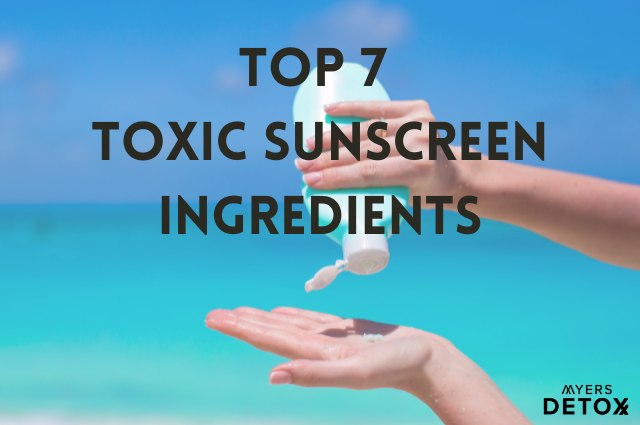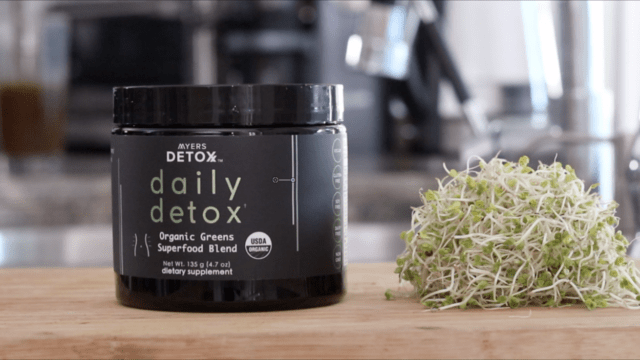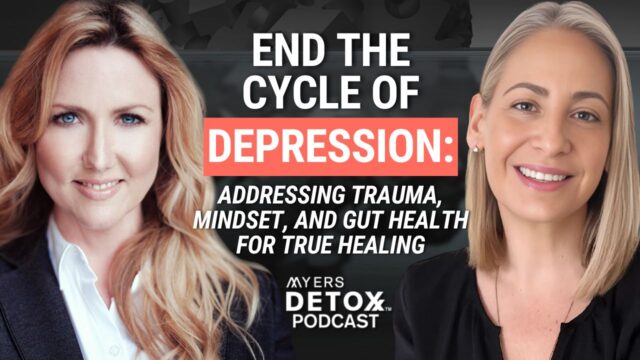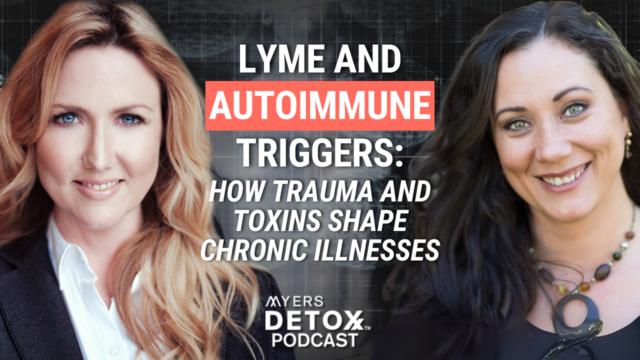Is your sunscreen toxic? Popular opinion would lead you to believe that the best way to protect yourself from skin cancer is to lather up with sunscreen and ward off the dangerous impact of UV rays. Unfortunately, research is showing that although sunscreen is effective at blocking radiation from the sun, it comes with dangerous side effects.
Specifically, the ingredients in most sunscreens are toxic to your health, and many act as endocrine disturbers.
Endocrine disturbing chemicals impact your hormonal system by either mimicking the effects of hormones or blocking hormonal activity.
In this article, you’ll learn:
- Which dangerous toxins are hiding in your sunscreen
- How these chemicals from toxic sunscreens interfere with your hormones
- The detrimental impact that sunscreen has on the environment
- Why it’s crucial to get enough sunlight on your skin
- Non-toxic sunscreen recommendations
Toxins In Your Sunscreen
There are two primary types of sunscreen UV filters — organic and inorganic.
Organic UV filters work by absorbing UV radiation from the sun, while inorganic filters work by reflecting and scattering the radiation.
While organic filters do a fantastic job of absorbing radiation, the chemical compounds in this type of sunscreen are readily absorbed by your skin, creating toxicity in your body. Inorganic filters, on the other hand, are not as easily absorbed and therefore are known to be much less toxic to your body[1].
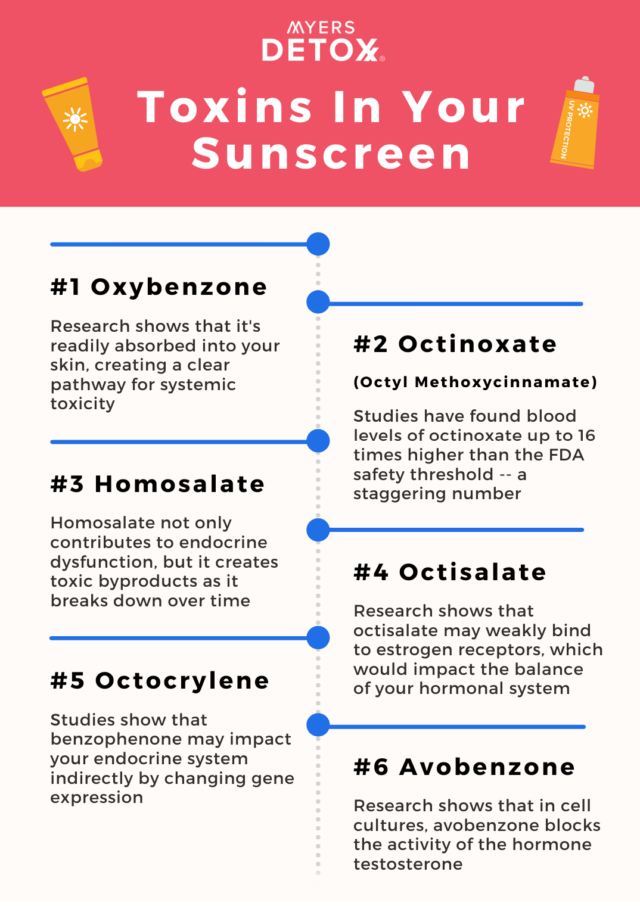
There are a handful of well-researched organic UV filters that have been studied for their toxic effects. These include[2]:
#1 Oxybenzone
The most well-researched and most troublesome sunscreen ingredient is oxybenzone. This organic filter is one of the most widely used ingredients in commercial sunscreens, and research shows that it’s readily absorbed into your skin, creating a clear pathway for systemic toxicity[1].
One of the major health concerns associated with oxybenzone is its endocrine-disturbing activity. Specifically, research shows[3][4][5][6][7]:
- Adolescent boys with high levels of oxybenzone in their blood have significantly lower testosterone levels.
- Female exposure to oxybenzone has been linked to an increased risk of endometriosis.
- Women exposed to oxybenzone that are carrying male fetuses experience shorter pregnancies.
- A congenital disability called Hirschsprung’s disease has been associated with oxybenzone exposure.
- Unhealthy birth weight (either too low or too high) has been found in babies whose mothers are exposed to oxybenzone.
- Oxybenzone exposure has been linked to breast cancer.
- Animal studies show that exposure to oxybenzone is associated with thyroid tumors and uterine hyperplasia (abnormal cells).
Moreover, several countries have already banned this ingredient due to its detrimental health effects and its toxic impact on the environment.
#2 Octinoxate (Octyl Methoxycinnamate)
Your skin readily absorbs octinoxate, and research shows that it continues to be absorbed for hours after the initial application. Studies have found blood levels of octinoxate up to 16 times higher than the FDA safety threshold — a staggering number.
As another endocrine-disrupting chemical, octinoxate affects thyroid hormone production, inhibiting the synthesis of this crucial compound. In addition, research shows that Octinoxate increases cell proliferation in cells that grow in response to estrogen exposure — a potential risk for breast cancer.
In addition to metabolic and female hormones, octinoxate has been shown to impact sperm count in males and display anti-androgen activity[8].
Some research also suggests that octinoxate may have a neurotoxic effect, impacting neurotransmitters like GABA, glutamate, and aspartate[9].
#3 Homosalate
Homosalate is another widely used organic filter that’s readily absorbed by your skin. While the EU limits the use of homosalate to a concentration of only 1.4%, In the U.S., manufacturers can add up to 15% of this toxic compound.
Homosalate not only contributes to endocrine dysfunction, but it creates toxic byproducts as it breaks down over time[10].
Studies on this harmful compound show[11]:
- The endocrine-disrupting effects of homosalate are particularly concerning since homosalate and other cosmetic UV filters have been identified in human breast milk samples — with one study showing up to 85% of milk contaminated.
- In human breast cancer cells, which grow and multiply in response to estrogen, homosalate exposure led to 3.5 times more cell growth and multiplication.
- In males, the androgen system may be impacted by homosalate.
- In addition to direct health concerns following homosalate exposure, the chemical may also enhance the absorption of pesticides in the body.
#4 Octisalate
Octisalate is absorbed into your skin at ten times above the FDA cutoff for systemic exposure. What’s more, in 2019, the FDA requested additional safety testing for this chemical and stated that there is insufficient data to determine whether octisalate can be classified as safe and effective to use in sunscreens. And yet, it is still a widely used ingredient.
Research shows that octisalate may weakly bind to estrogen receptors, which would impact the balance of your hormonal system[2].
#5 Octocrylene
Octocrylene is absorbed through your skin at levels 14 times higher than the FDA cutoff, and again, the FDA is yet to determine whether this chemical can be classified as safe and effective.
Research shows that octocrylene can degrade into benzophenone over time, which is a derivative of oxybenzone[12]. In addition to all the detrimental effects that oxybenzone exhibits, studies show that benzophenone may impact your endocrine system indirectly by changing gene expression.
What’s more, animal research shows that benzophenone can cause liver hypertrophy and that this chemical can accumulate in the blood, creating toxicity in the liver and kidneys[13].
#6 Avobenzone
Avobenzone is another widely used UV filter that provides protection from UVA rays and is often used with other filters to offer more broad-spectrum protection from the sun.
Research shows that in cell cultures, avobenzone blocks the activity of the hormone testosterone. Furthermore, it appears that when combined with other common ingredients found in sunscreen, avobenzone exhibits glucocorticoid-like activity. Glucocorticoids play an important role in inflammation, immunity, and the breakdown of nutrients in your body[14].
Sunscreen Recall Due To Toxic Benzene
In 2021, Johnson and Johnson had to recall several of its sunscreen brands because they were found to have contained benzene, a known human carcinogen. Independent testing confirmed that several of the sunscreens that Johnson and Johnson manufacture, under brands like Aveeno and Neutrogena, were contaminated.
C.V.S. also had to pull some of their own sunscreens off the shelves after finding similar chemicals had contaminated their formulas. Then in the Fall, Coppertone (another large manufacturer of sunscreen) had to recall many of their sunscreens for the same reason.
And this problem is not just an American one. In 2022, there was a massive sunscreen recall in Australia as well.
Why? You guessed it — Benzene. And its #7 on our list of top 7 toxic sunscreen ingredients to avoid.
Sunscreen is filled with these types of toxic chemicals and several places have actually BANNED certain sunscreens because of this (Hawaii is one of them).
Unfortunately, benzene — the chemical that got all of these conventional sunscreens recalled — isn’t just in sunscreen. This dangerous toxin has contaminated many products.
It’s in oil, rubber, plastic, and pesticides. [25] It’s even in the air thanks to things like:
- cigarette smoke
- gas-burning cars
- and wildfires. [25]
That means that even if you don’t use conventional sunscreen, your more than likely have some benzene in your body.
Safer Alternatives to Toxic Sunscreens
Titanium dioxide and zinc oxide offer safer alternatives to the above chemicals. These compounds are inorganic UV filters which reflect and scatter sunlight, as opposed to absorbing it.
Titanium Dioxide – Still Potentially Toxic
There is some debate as to whether titanium dioxide is safe. It is found in many natural sunscreens. The Environmental Working Group says that “Titanium dioxide is a possible human carcinogen, but only for inhalation and products that may be aerosolized (airborne). It appears to have low skin penetration, but inhalation is a concern.” So, I think it is likely safe in a sunscreen lotion.
Nanoparticle or micronized titanium dioxide, however, is concerning. Nanoparticles of titanium dioxide are used in sunscreens because they are colorless at that size and still absorb ultraviolet light. While many are praising this new technology, others are warning of its inherent dangers to our bodies.
A study at the University of British Columbia, “Induction of Fibrogenic Mediators by Fine and Ultrafine Titanium Dioxide in Rat Tracheal Explants” (1999) found that ultrafine particles of the anatase form of titanium dioxide, which are less than 0.1 microns, are pathogenic or disease-causing. Other studies have found that the smaller the particle size, the more toxic the mineral[15].
Nanoparticle titanium dioxide penetrates the cells and can cause DNA damage after exposure to sunlight (Powell, et. al. 1996). The fear is that this could lead to cancer in the skin.
Coarse or fine particles of titanium dioxide are safe and effective at deflecting and absorbing UV light, but consumers should avoid using micronized titanium dioxide, either in sunscreens or cosmetics[16].
Zinc Oxide
Zinc oxide is the most effective and safest mineral UV filter. Zinc sits on top of your skin and prevents UV damage, acting as a physical barrier. It’s just as effective as a chemical filter like oxybenzone without the toxic side effects.
If you’ve already got enough unfiltered sunlight for the day’s vitamin D needs and want some UV protection, zinc oxide is your best, safest bet.
Mark Sisson thinks that nanoparticle zinc is safe. “If you’re worried about looking silly with white streaks all over your face and body, you can opt for safe nanoparticle zinc oxide that disappears on your skin. There is some concern that these nanoparticles of zinc oxide can cause health problems, but the evidence seems to weigh heavily toward the ‘all safe’ side[17].
One study found that while zinc oxide does penetrate some of the outer layers of the epidermis (more so when the skin is sunburnt), it does not achieve transdermal penetration for systemic distribution[18].”
The Importance Of Healthy Sun Exposure
While there are plenty of toxin-free sunscreens out there, there is one more crucial topic to cover before you go covering every inch of your body with a more natural product, and that’s the fact that sun exposure is crucial for your health.
Of course, you don’t want to overdo it and burn your skin, but getting natural sunlight on your body every day is vital to overall well being.
First, sunlight is crucial for the natural production of vitamin D, which many people are deficient in. Vitamin D is essential for calcium absorption in your body and helps to maintain calcium and phosphorous levels — vital for healthy bones.
In addition, vitamin D plays a role in immunity, inflammation, neuromuscular function, and glucose metabolism[19].
Aside from its role in vitamin D synthesis, sunlight also impacts[20]:
- Your circadian rhythm
- The production of melatonin (sleep hormone)
- The production of serotonin (feel-good hormone)
- Immune processes that prevent autoimmune disease
- Gene repair, reducing melanoma risk
- Stress-response by increasing endorphins
Environmental Impact Of Sunscreen
The dangers of the harmful chemicals in your sunscreen aren’t limited to your body. When you swim in the ocean or even take a shower after a day in the sun, these chemicals can leach into the water supply.
Research shows that the same chemicals that have a dangerous impact on your health may also negatively affect marine life — specifically coral reefs. Some of the ways these compounds impact the health of our oceans include[21]:
- Impaired growth and synthesis of green algae.
- Accumulation in the tissue of coral, damaging the coral reefs and creating bleaching, DNA damage, and sometimes even killing the coral altogether.
- Induce birth defects in mussels.
- Damaged immune and reproductive systems in sea urchins.
- Decreased fertility in fish, with female fish displaying male characteristics.
- Accumulation in the tissues of dolphins, which can then transfer to their young.
Oxybenzone, in particular, has a devastating impact on coral reefs. By making the water around the corals toxic, it inhibits their symbiotic relationship with algae. It’s the algae in the waters that give the coral reefs their beautiful color, and the result of this toxic insult is bleached reefs. What’s even more disturbing, the absence of algae, and the subsequent bleaching leaves the coral more vulnerable to diseases, which ultimately leads to their death[3].
Aside from the crucial role that coral reefs play in the ocean’s ecosystem, they also provide food, income, and protection to over half a billion people worldwide. Everything from fishing to diving to snorkeling can be enjoyed by tourists when they visit these beautiful coral reefs and supply the locals with a steady source of income. When these reefs are damaged, the ripple effect beyond the environmental concerns is substantial[22].
Why You Should Drink This Detox Formula
No matter what type of sunscreen you use, I encourage you to drink this detox blend.
The main ingredient in Daily Detox is one of the best things you can consume if you want to protect your body from sunscreen toxins like benzene. The formula contains large amounts of raw, fermented broccoli sprouts.

Eating broccoli sprouts is one of the best ways to support your body’s natural ability to detox. Why?
- They contain a plant compound that studies show can support your health by “keeping carcinogens and irritating pollutants at bay”. [23, 24]
- They also activate an immunity-boosting gene pathway in your body (known as NRF2) that helps your cells survive a broad range of environmental toxins. [23]
- And a study of over 300 men and women showed broccoli sprouts “produce rapid, significant, and sustained excretion of benzene”. [23]
Regardless of which sunscreen you use, you should be consuming broccoli sprouts daily to protect your health. Broccoli sprouts can:
- Boost cellular health
- Enhance your body’s detoxing ability
- Promote gut health and better digestion
- Support a healthy inflammatory response
- And support your liver’s defense against a wide range of carcinogens
There’s no doubt that eating broccoli sprouts is amazing for you. But here’s the catch: You have to eat broccoli sprouts raw to experience the detoxing benefits.
That’s why the detox formula on the next page is so great!
It’s an organic superfood formula that blends raw, fermented broccoli sprouts with other green foods and mushrooms that work in combination to encourage detoxification better than just taking the sulforaphane in broccoli on its own.
The blend features:
- A therapeutic dosage of broccoli sprouts for advanced detoxing, immunity and respiratory protection*
- Multiple herbs and green foods to encourage daily cleansing*
- 6 types of mushrooms that boost immunity and provide added detox support*
- Natural fiber for healthy elimination support*
- Delicious fruits that provide excellent antioxidant defense
- Metabolism-boosting ingredients*
- And much more!
Takeaway
The way in which we’ve been trained to use sunscreen to protect ourselves from the dangerous threats of sun exposure may do much more harm than good.
First of all, you need sun exposure for various reasons — vitamin D synthesis being chief among them.
And second, and perhaps even more important, is the toxic nature of most of the sunscreens on the market.
To protect yourself and your family from toxic sunscreen, always look at the ingredients on the labels of your sunscreens. If you see any of the following, avoid them and choose an alternative:
- Oxybenzone
- Octinoxate
- Homosalate
- Octisalate
- Octocrylene
- Avobenzone
Finally, no matter what type of sunscreen you use, make sure you are taking steps to support your health and liver function with detox.
Broccoli sprouts are incredibly effective for this, but they aren’t easy to fit into every meal. That’s why Daily Detox makes protecting your health from everyday toxins so easy.
Every serving of this detox drink gives you all of the fermented broccoli sprouts your body needs to deal with sunscreen toxins efficiently. Check it out!


